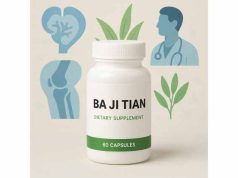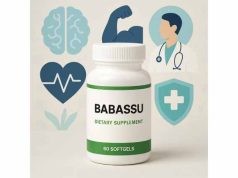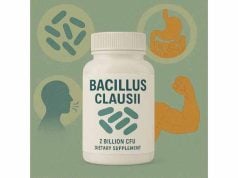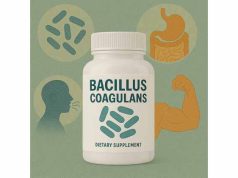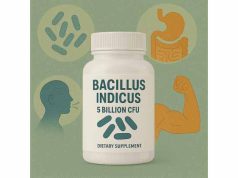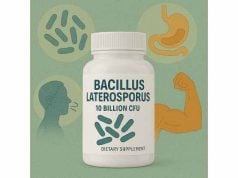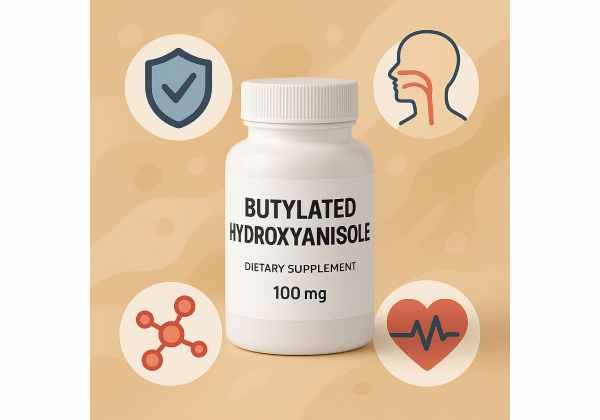
Butylated hydroxyanisole (BHA) is a synthetic antioxidant widely used in the food, pharmaceutical, and cosmetic industries to preserve freshness and prevent spoilage. Recognized for its powerful ability to slow down oxidation, BHA is often added to processed foods, supplements, oils, and fats to extend shelf life and maintain product quality. While some tout its benefits as a preservative, BHA has become a subject of consumer concern and scientific scrutiny due to ongoing debates about its safety, health impacts, and regulatory status. This comprehensive guide dives into BHA’s properties, how it works, its primary uses, safe dosage guidelines, and the latest research on side effects, so you can make informed choices for yourself and your family.
Key Takeaways
- Butylated hydroxyanisole (BHA) is a synthetic antioxidant used to prevent fats and oils from becoming rancid in foods, supplements, and cosmetics.
- BHA is effective at extending shelf life but is controversial due to potential health risks when consumed in high amounts over time.
- Most regulatory bodies allow BHA in food and personal care products at low, controlled concentrations, but some countries have stricter regulations or bans.
- Some studies link high BHA intake to possible cancer risk in animals, but typical dietary exposure for humans is considered low-risk.
- Consumers can minimize exposure by reading labels, choosing fresh or unprocessed foods, and staying informed about current safety research.
Table of Contents
- Butylated Hydroxyanisole (BHA): What It Is and How It’s Used in Food and Supplements
- How BHA Works: Antioxidant Mechanisms and Biological Effects
- Benefits and Common Uses of Butylated Hydroxyanisole in Consumer Products
- Safety Profile, Potential Side Effects, and Interactions of BHA
- Dosage Limits and Guidelines for BHA in Food and Supplements
- Butylated Hydroxyanisole: Frequently Asked Questions (FAQ)
Butylated Hydroxyanisole (BHA): What It Is and How It’s Used in Food and Supplements
Butylated hydroxyanisole, abbreviated as BHA, is a synthetic compound formed by combining two chemicals: 2-tert-butyl-4-hydroxyanisole and 3-tert-butyl-4-hydroxyanisole. It was first introduced in the late 1940s and quickly became a staple antioxidant in the food and cosmetics industries due to its impressive ability to prevent rancidity in oils and fats.
What Does BHA Look Like?
BHA is a waxy, white or slightly yellow solid with a mild, faintly aromatic odor. It is fat-soluble, making it an ideal choice for stabilizing products rich in oils or fats.
Main Uses in Industry
- Food Preservation: BHA is commonly added to processed foods such as breakfast cereals, snack foods, chips, chewing gum, butter, lard, shortening, baked goods, and dehydrated potatoes. It slows the oxidation process that leads to spoilage, off-flavors, and color changes.
- Nutritional Supplements: Many vitamin and supplement manufacturers use BHA to protect fat-soluble nutrients (like vitamins A, D, E, and omega-3 fatty acids) from degradation during storage.
- Cosmetics and Personal Care: BHA is included in lipsticks, moisturizers, lotions, deodorants, and hair products to prevent oils from turning rancid and to extend shelf life.
- Packaging: Sometimes, BHA is incorporated into food packaging materials to further slow down spoilage from within.
Global Regulatory Status
- United States: The Food and Drug Administration (FDA) allows BHA in food at concentrations up to 0.02% of the total fat or oil content.
- European Union: Permitted as E320, BHA is subject to strict limits, especially in foods intended for infants or young children.
- Other Countries: Some nations (such as Japan) have banned or severely restricted BHA in food products due to safety concerns.
How to Identify BHA on Labels
Look for “butylated hydroxyanisole,” “BHA,” or the additive code “E320” on ingredient lists. It may also appear in non-food items with similar labeling.
Why Is BHA Used Instead of Natural Preservatives?
BHA is prized for its stability, effectiveness at very low concentrations, and low cost. While natural antioxidants like vitamin E (tocopherol) or rosemary extract are gaining ground, they often require higher dosages or may alter flavor, which makes BHA attractive to manufacturers of long-shelf-life goods.
Common Foods Containing BHA
- Packaged snacks (chips, crackers)
- Breakfast cereals
- Chewing gum
- Processed meats
- Vegetable oils and shortening
- Instant mashed potatoes
Key Takeaway
BHA is a widely used synthetic preservative designed to slow the deterioration of fats and oils, helping keep foods and supplements fresh. Its prevalence means most consumers ingest small amounts regularly, usually well below regulatory limits.
How BHA Works: Antioxidant Mechanisms and Biological Effects
Understanding BHA’s function requires a basic grasp of oxidation and why preventing it matters for food safety, shelf life, and human health.
The Science of Oxidation
Oxidation is a chemical reaction that occurs when oxygen interacts with fats, oils, and other nutrients in foods. This reaction produces free radicals—unstable molecules that can degrade food, create off-flavors and odors, and diminish nutritional quality. In the human body, oxidative stress is linked to aging, chronic disease, and cell damage.
BHA as a Synthetic Antioxidant
BHA acts by neutralizing free radicals and interrupting the chain reactions that cause fats and oils to become rancid. Its structure allows it to “donate” hydrogen atoms to free radicals, stabilizing them and preventing further damage to food molecules.
How BHA Functions in Different Products
- In Food: BHA is added during food processing. It dissolves into fats and prevents the initial steps of oxidative spoilage, ensuring the product stays fresh longer.
- In Supplements: Protects oil-based nutrients (like omega-3s, fat-soluble vitamins) from oxidizing, thus maintaining potency and flavor.
- In Cosmetics: Prevents plant or synthetic oils from turning rancid, which can otherwise create unpleasant odors and change the texture or efficacy of the product.
What Happens to BHA in the Human Body?
When ingested, BHA is absorbed in the gastrointestinal tract and then metabolized in the liver. Most is broken down and excreted in urine. Small amounts may be stored in fatty tissues, but current evidence suggests BHA does not accumulate at levels considered harmful under typical exposure.
Potential Biological Effects
- Antioxidant Effects: In small amounts, BHA can act as an antioxidant in the body, reducing certain oxidative reactions.
- Pro-oxidant Potential: At high concentrations, or in combination with other factors, BHA may have pro-oxidant (cell-damaging) effects, which is part of why excessive intake is discouraged.
- Hormonal and Cellular Effects: Animal studies have suggested BHA could influence certain enzymes, cell signaling pathways, or even hormone metabolism, although effects in humans at real-world exposure are not well established.
BHA Compared to Other Synthetic Antioxidants
BHA is often used in tandem with butylated hydroxytoluene (BHT), another synthetic preservative. Both have similar properties, but may be favored in different products based on stability, solubility, and regulatory status.
Summary Table: How BHA Works
| Property | Function | Impact |
|---|---|---|
| Antioxidant activity | Prevents fat oxidation | Extends shelf life, preserves flavor |
| Fat solubility | Dissolves in oils and fats | Used in high-fat products |
| Metabolism in body | Absorbed and mostly excreted | Low accumulation with typical use |
| Stability | Heat and storage stable | Suitable for many packaged foods |
Bottom Line
BHA is highly effective at preventing spoilage and extending the shelf life of fat-containing foods and supplements, but its safety at higher or long-term exposure remains a subject of ongoing research.
Benefits and Common Uses of Butylated Hydroxyanisole in Consumer Products
BHA’s widespread use is driven by its cost-effective, reliable performance as a preservative. Let’s explore why manufacturers rely on BHA and what benefits (and drawbacks) it brings to the table for both producers and consumers.
Top Benefits of BHA in Food and Supplements
- Extends Shelf Life: BHA’s antioxidant properties significantly slow down the rate at which fats and oils turn rancid, keeping foods safe and palatable for longer periods.
- Maintains Nutritional Quality: By preventing the breakdown of fat-soluble vitamins and essential fatty acids, BHA helps retain the nutritional value of fortified foods and dietary supplements.
- Preserves Flavor and Appearance: Oxidized fats can taste and smell unpleasant, while causing browning or discoloration. BHA keeps products looking and tasting fresh.
- Supports Food Safety: By inhibiting the growth of certain spoilage organisms, BHA contributes to a lower risk of foodborne illness, especially in high-fat foods.
Common Product Categories Using BHA
- Packaged Snacks and Processed Foods: BHA is found in many chips, crackers, cereals, cookies, and chewing gums to prevent spoilage during storage and transport.
- Oils, Fats, and Margarines: Both retail and commercial cooking oils often include BHA for stability.
- Animal Feed and Pet Foods: Ensures freshness in fat-rich pet foods and animal feeds, which are prone to rapid spoilage.
- Dietary Supplements: Multivitamins, omega-3 capsules, and other oil-based supplements may contain BHA for potency preservation.
- Cosmetics and Personal Care Products: Lip balms, creams, and deodorants use BHA to keep oils fresh and stable.
- Pharmaceuticals: BHA stabilizes certain medications and ointments containing fats or oils.
Other Notable Uses
- Packaging: Some food packaging contains BHA to help preserve contents during extended shelf time.
- Industrial Applications: BHA’s antioxidant qualities are sometimes used in rubber and plastic manufacturing, though not relevant to food safety.
Potential Health Benefits (and Limitations)
While BHA’s main function is as a food-grade antioxidant, it does not provide direct nutritional value or health benefits to consumers. The “benefit” is largely in improved product safety, longer shelf life, and reduced food waste. However, some researchers have investigated whether BHA’s antioxidant capacity could have positive health effects at very low exposure, but there is not enough data to recommend it for this reason.
Consumer Perspective: Pros and Cons
- Pros: Convenience, less food spoilage, longer-lasting pantry staples, more stable supplements.
- Cons: Potential health concerns with high intake, preference for natural preservatives, possible allergenicity in sensitive individuals.
Trends Toward Cleaner Labels
With increasing consumer demand for clean-label and natural ingredients, some brands are moving away from synthetic preservatives like BHA in favor of rosemary extract, tocopherols (vitamin E), or ascorbic acid (vitamin C). However, these alternatives may have shorter shelf lives or alter the taste and appearance of products.
Summary Table: BHA Benefits and Uses
| Benefit | Example Products | Notes |
|---|---|---|
| Shelf life extension | Chips, oils, cereals | Used at very low levels |
| Maintains nutrient quality | Vitamin capsules | Protects fat-soluble nutrients |
| Flavor/appearance stability | Baked goods, margarine | Prevents rancidity and spoilage |
| Food safety | Animal feed, supplements | Reduces risk of spoilage |
Key Takeaway
BHA is a widely used, highly effective antioxidant preservative, but it is not without controversy. Understanding where it appears and why can help you make choices that align with your health goals and values.
Safety Profile, Potential Side Effects, and Interactions of BHA
The safety of butylated hydroxyanisole (BHA) remains a widely discussed topic in food science, nutrition, and public health. While regulatory agencies generally consider BHA safe at low levels, ongoing research and consumer advocacy groups have raised important questions about its long-term effects, especially with repeated or high intake.
Overview of BHA Safety Regulations
- United States: The FDA classifies BHA as “generally recognized as safe” (GRAS) for use in foods at concentrations up to 0.02% of total fat or oil content.
- Europe: The European Food Safety Authority (EFSA) allows BHA as food additive E320 but sets strict maximum levels, particularly for foods consumed by infants and children.
- Canada, Australia, and Asia: Similar limits apply, with some variance in permitted foods and concentration.
Potential Side Effects in Sensitive Individuals
- Allergic Reactions: Rarely, people may experience hives, itching, or swelling after consuming products with BHA, especially if they have a history of food sensitivities or allergies.
- Digestive Upset: In some cases, BHA may cause mild stomach upset, nausea, or even diarrhea, especially in higher amounts or when combined with other additives.
- Skin Contact: In cosmetics, BHA is generally safe at low levels, but it can occasionally cause skin irritation, especially in people with sensitive skin or dermatitis.
Controversial Health Concerns: What Does the Science Say?
- Carcinogenicity: Animal studies have shown that high doses of BHA can cause tumors in the forestomachs of rodents. However, humans lack a forestomach, and typical dietary exposures are far lower than doses used in these studies. Regulatory authorities generally consider these findings not directly applicable to human risk at current exposure levels, though the International Agency for Research on Cancer (IARC) classifies BHA as “possibly carcinogenic to humans” (Group 2B).
- Endocrine Disruption: Some in vitro and animal studies suggest BHA may influence hormone activity or thyroid function, but this effect has not been clearly demonstrated in humans.
- Genetic and Reproductive Effects: No strong evidence links BHA at approved levels to genetic mutations or reproductive harm in humans.
Risk of Accumulation and Long-Term Exposure
- Bioaccumulation: Most BHA is rapidly metabolized and excreted, though small amounts can be stored in fatty tissues. Long-term effects of such low-level accumulation remain uncertain.
- Combined Effects: BHA is often consumed alongside other synthetic antioxidants (like BHT) and preservatives. The “cocktail effect” of multiple additives over years is not fully understood.
Sensitive Populations and At-Risk Groups
- Pregnant and Breastfeeding Women: While no conclusive evidence shows harm, it’s generally recommended to limit unnecessary additive exposure during pregnancy and breastfeeding.
- Infants and Young Children: Some countries restrict BHA in foods targeted at children due to developing organ systems and lower body weight.
- People with Allergies or Asthma: Those with known additive sensitivities or respiratory allergies may react more strongly to BHA, though such cases are uncommon.
Drug and Nutrient Interactions
- Drug Interactions: No direct, clinically significant interactions with medications are well established for BHA, but if you are taking drugs processed by the liver, consult a doctor before consuming large quantities of products with BHA.
- Nutrient Absorption: No evidence suggests BHA impairs vitamin or mineral absorption at approved levels.
How to Minimize BHA Risks
- Read food and supplement labels, avoiding products with “butylated hydroxyanisole,” “BHA,” or “E320” if you wish to limit exposure.
- Opt for fresh, whole foods and minimally processed products.
- Look for “BHA-free” or “no synthetic preservatives” on packaging.
Summary Table: BHA Side Effects and Safety
| Safety Concern | Typical Risk at Approved Levels | High-Risk Groups |
|---|---|---|
| Cancer (rodent studies) | No evidence at low human exposure | High-dose/long-term users |
| Allergy/sensitivity | Rare, possible | Allergic or sensitive individuals |
| Digestive upset | Uncommon, usually mild | Sensitive individuals |
| Skin irritation | Rare, usually with topical use | Sensitive skin |
| Hormonal effects | Uncertain at typical levels | Pregnant/nursing women, children |
Bottom Line
When used as permitted in foods, supplements, and cosmetics, BHA is considered safe for the vast majority of people. However, those wishing to avoid any risk should minimize processed foods and read labels carefully.
Dosage Limits and Guidelines for BHA in Food and Supplements
Butylated hydroxyanisole is never consumed as a standalone supplement; instead, it’s an additive found in trace amounts across various foods, supplements, and personal care products. Understanding how much BHA you might ingest—and how to stay within safe boundaries—is key to making informed choices.
Regulatory Dosage Limits
- United States (FDA): The limit is 0.02% of total fat or oil content in any product.
- European Union (EFSA): Acceptable daily intake (ADI) is 1 mg per kilogram of body weight.
- Other countries: Most industrialized nations align with the 1 mg/kg body weight/day standard.
How Much BHA Do People Typically Consume?
- Average Intake: Studies show the average daily BHA intake for most consumers is well below the regulatory maximum, often 10–20% of the ADI.
- High-Intake Scenarios: Individuals who eat a diet rich in processed foods, snack foods, and certain supplements may approach higher intake levels, but rarely exceed safety thresholds.
How to Calculate Potential Intake
- Check ingredient lists for BHA (butylated hydroxyanisole, E320).
- Consider the fat content of the food—higher fat items (like chips, oils, baked goods) may contain more BHA.
- Add up all potential sources in your daily diet to estimate exposure. Remember, even with multiple sources, most people remain under the ADI.
Supplement and Cosmetic Use
- Supplements: When present, BHA content is usually extremely low—measured in micrograms to milligrams per serving.
- Cosmetics: Skin absorption is possible, but the vast majority of BHA is excreted and does not accumulate to dangerous levels with normal use.
Guidelines for Special Populations
- Pregnant Women, Infants, and Children: Limit or avoid foods and products containing BHA whenever possible, as a precaution.
- Individuals with Allergies: If you have a known allergy to BHA or related preservatives, avoid all sources.
- Health-Conscious Consumers: Choose minimally processed foods, organic products, and “BHA-free” labels to reduce additive intake.
When to Be Extra Cautious
- If you consume multiple servings of packaged snacks, cereals, processed meats, or supplements daily, consider reviewing total BHA intake.
- People with compromised liver or kidney function should be particularly mindful of additive intake.
Alternative Preservatives
- Natural antioxidants like tocopherols (vitamin E), ascorbic acid (vitamin C), and rosemary extract are increasingly used in “clean-label” products.
- Shelf life may be shorter, but health concerns are generally lower.
Practical Tips to Limit BHA Exposure
- Focus on whole, unprocessed foods like fruits, vegetables, whole grains, fresh meat, and unrefined oils.
- Prepare snacks at home and cook in bulk for freshness without added preservatives.
- Check supplement and cosmetic ingredient lists, especially if you use multiple products daily.
Summary Table: BHA Dosage Guidelines
| Regulation | Limit | Who Should Be Cautious |
|---|---|---|
| US FDA | 0.02% of fat/oil in food | Children, pregnant women |
| EU/EFSA | 1 mg/kg body weight/day (ADI) | Sensitive or high-risk groups |
| Typical diet | Usually much lower than limit | Processed food-heavy diets |
| Supplements/cosmetics | Micrograms to milligrams per serving | Allergy-prone individuals |
Key Takeaway
For most people, exposure to BHA from diet and products remains well within established safety margins. Those wishing to avoid BHA can do so by reading labels and prioritizing minimally processed foods and products.
Butylated Hydroxyanisole: Frequently Asked Questions (FAQ)
Is butylated hydroxyanisole (BHA) safe to eat?
When consumed within regulatory limits, BHA is considered safe for the general population. Most people’s intake is far below the maximum allowed. Those concerned can minimize exposure by limiting processed foods and checking ingredient lists.
What is the difference between BHA and BHT?
Both are synthetic antioxidants used as preservatives. BHA is slightly more heat-stable, while BHT is used in a wider variety of food and non-food products. Both have similar safety profiles and regulatory limits.
Does BHA cause cancer in humans?
High doses of BHA have caused tumors in animal studies, but there is no clear evidence of cancer risk in humans at approved exposure levels. Regulatory agencies continue to monitor ongoing research.
Can BHA cause allergic reactions?
Allergic reactions to BHA are rare but possible, usually manifesting as skin rash, itching, or swelling. If you have a known sensitivity, avoid products containing BHA or E320.
How can I avoid BHA in my diet?
Choose fresh, whole foods and check labels for BHA, “butylated hydroxyanisole,” or “E320.” Many brands now advertise “no synthetic preservatives” for consumers seeking to avoid additives.
Is BHA allowed in organic foods?
No. Certified organic foods do not contain synthetic preservatives like BHA or BHT.
Does BHA interact with medications?
There is no well-documented evidence of significant drug interactions with BHA at typical dietary exposures, but people with liver or kidney disease should consult their doctor if concerned.
Disclaimer:
The information provided in this article is for educational purposes only and is not intended as a substitute for professional medical advice, diagnosis, or treatment. Always consult a qualified healthcare provider before making dietary or supplement changes, especially if you have underlying health conditions or allergies.
If you found this article helpful, please consider sharing it on Facebook, X (Twitter), or your favorite social media platform. Your support helps us continue providing reliable, science-based wellness resources for everyone!

